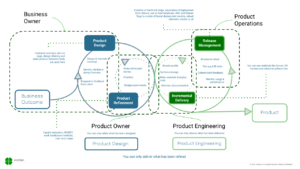Whenever there is a product for a customer, there is a value stream.
-John Shook and Mark Rother, Learning to See
Creating more value for customers is a core business strategy. With more technologies being developed, companies have been optimizing their software delivery to get the best value out of their products or services. Instead of focusing on individual functions, companies are now developing an interest in the end-to-end value chain. Software development is no longer just the business of IT departments.
Company leaders and management are taking an active role in making sure that the software delivery process is driving value to the business. In a way, every organization has become a software company.
Unfortunately, even after investing considerable time and resources in IT transformations, companies still experience misalignment in business vision, strategies, and goals.
While they may have implemented new ways of working, such as Agile and DevOps, there is often a disconnect between software delivery and overall business value.
What is the missing key? How can we make introducing change more successful? The answer may be this: identifying and managing value streams.
As defined by iSixSigma:
“A value stream is all the steps (both value-added and non-value added) in a process that the customer is willing to pay for to bring a product or service through the main flows essential to producing that product or service.”
As this states, more than just optimizing the software delivery process, companies need to understand how to optimize the end-to-end flow of business value to their customers. Once they identify their value streams, the focus can start on strengthening value-added activities while minimizing nonvalue-added ones. To do this we rely on the practices of value stream mapping and value stream management.
Value stream mapping and value stream management both stem from lean philosophies of increasing operational efficiency while reducing risk and waste. Their main goal is to maximize customer value by helping guide companies in making the value stream visible and optimizing flow. When customer value increases, it will consequently generate higher returns for the company.
The question now is: what are value stream mapping and value stream management? Both have the acronym VSM, are they the same thing? If not, how do we differentiate one from the other?
What is value stream mapping and how does it benefit an organization?
Value stream mapping is a lean management tool that enables any organization to “map” or examine their overall process across all departments involved from end to end. It allows for a better understanding of all value-added and non-value-added steps in the value chain. Simply, value stream mapping provides a bird’s s-eye view of all the key steps and data needed for the entire service or product development to deliver value to customers.
It is a holistic approach that involves documenting, analyzing, and improving the flow of resources to produce a certain product or service. It enables organizations to visualize how each team performs their work, how their functions fit together, and how they can improve the overall product development process as a team and as individual divisions.
Most trace back the origins of value stream mapping to Toyota Motor Corporation’s “material and information flow,” which was outlined in John Shook and Mike Rother’s book Learning to See published in 1998, and other books.
Its roots however are far older, dating back to process mapping techniques in lean manufacturing popularized in the second half of the 20th century.
As this value mapping technique grew in popularity among manufacturing businesses, other industries have begun adopting the process, especially in software development, IT operations, and marketing.
With the advent of Agile and the subsequent application of Value Stream Mapping practices to knowledge work, we are seeing a resurgence in interest in the topic.
Value stream mapping can be simple or complex, depending on the scope of product development. It can be used to make a comprehensive visualization of a highly complex process or focus on a specific segment. Regardless of the type of product or service produced, value stream mapping enables all types of organizations to perform more efficiently.
To perform value stream mapping, teams need to create the following components:
- Current state map: the current methodology of how products or services are produced for customers.
- Future state map: the methodology or conditions that will enable an organization to achieve the ideal state of value stream for customers.
- Action plan: the steps necessary to move from the current state to the future state.
Through value stream mapping, teams can determine where the value is created and where it is not. It also determines how each team contributes to the actual value of a particular product or service.
Value stream mapping also improves productivity and business efficiency by identifying waste, pain points, and bottlenecks; encouraging cross-functional collaboration; and enhancing product or service quality.
It is this cross-functional collaboration that creates the real benefits of Value Stream Mapping. For many, it may be the first time seeing the end-to-end system, and with that comes understanding. The collaborative nature of creating the Value Stream Map enables those involved to understand each other’s roles in delivering value, further cementing a common vision.
I often like to say, paraphrasing Eisenhower, that the true value of a VSM exercise is in the mapping, not the map.
How does value stream management differ from value stream mapping?
Forrester Research used the term value stream management to describe a software development process from end to end. According to Forrester Research’s definition, value stream management is the “combination of people, process, and technology that maps, optimizes, visualizes, and governs business value flow through heterogeneous enterprise software delivery pipelines.
” In a nutshell, it facilitates the end-to-end process between ideation and customer delivery and examines the work performance within organizations, functions, and departments.
The goal is to optimize business value and eliminate waste from the development and delivery processes. It also aims to increase efficiency and quality, while removing disconnections between processes.
Value stream management begins with value stream mapping. After getting an end-to-end visualization of all the value streams, organizations need to manage and monitor the entire software delivery process from the moment an idea is created to build, test, deliver, and feedback.
Data is gathered using measurements, metrics, and KPIs. Using metrics, company leaders can see the impact of each organizational effort in delivering value. They can then implement actions based on these metrics and measure their progress against KPIs.
For value stream management to be effective, operational and skill-centric silos must be broken down, cross-functional team collaboration must be implemented, value stream governance must be embedded in the software delivery process, and workflows must be automated.
This will empower organizations to not only create new value but also help ensure continuous improvement in their Agile and DevOps practices.
When organizations adopt value stream management
They can efficiently gather data, track performance over time, and improve their software delivery pipelines. Value stream management enables them to monitor their actual lead time, cycle time, and throughput, as well as create more realistic goals and better alignment across the organization.
There are many benefits of implementing value stream management. As we enter the next age of software development, value stream management empowers businesses to make data-driven decisions and more efficient investments.
This capability could even protect your organization from sudden social and economic disruptions. For example, understanding value stream data will enable companies to intelligently realign resources, support stakeholders, and track progress as the company shifts to remote work during community restrictions.
Conclusion
Value stream mapping and value stream management are useful tools in driving business value, creating higher engagement, and enabling faster innovation.
Value stream mapping provides a collaborative cross-functional environment to visualize how work is done and identify bottlenecks. The narrative created in a value stream mapping exercise is a powerful tool for creating common understanding and alignment.
Value stream management quantifies and solidifies much of what we see in the adoption of DevOps practices. It allows organizations to visualize the flow and rapidly identify constraints in their systems. It opens up the door to a more holistic view of how an organization delivers value.
Combined with value stream mapping, value stream management creates a value-focused conversation that can help organizations overcome barriers to adoption. To truly get the value from the tooling, businesses need to take it beyond technology to look at the end-to-end customer journey.
When implementing value stream management, it is important to consider that not everybody will be motivated by the data. Some people may feel the visibility to be intrusive.
To counter this, leaders need to develop a culture that encourages psychological safety, and collaborative approaches like Value Stream Mapping can greatly help with this.
With this in mind, combining value stream management and value stream mapping can produce great results to help you drive your organization forward.




